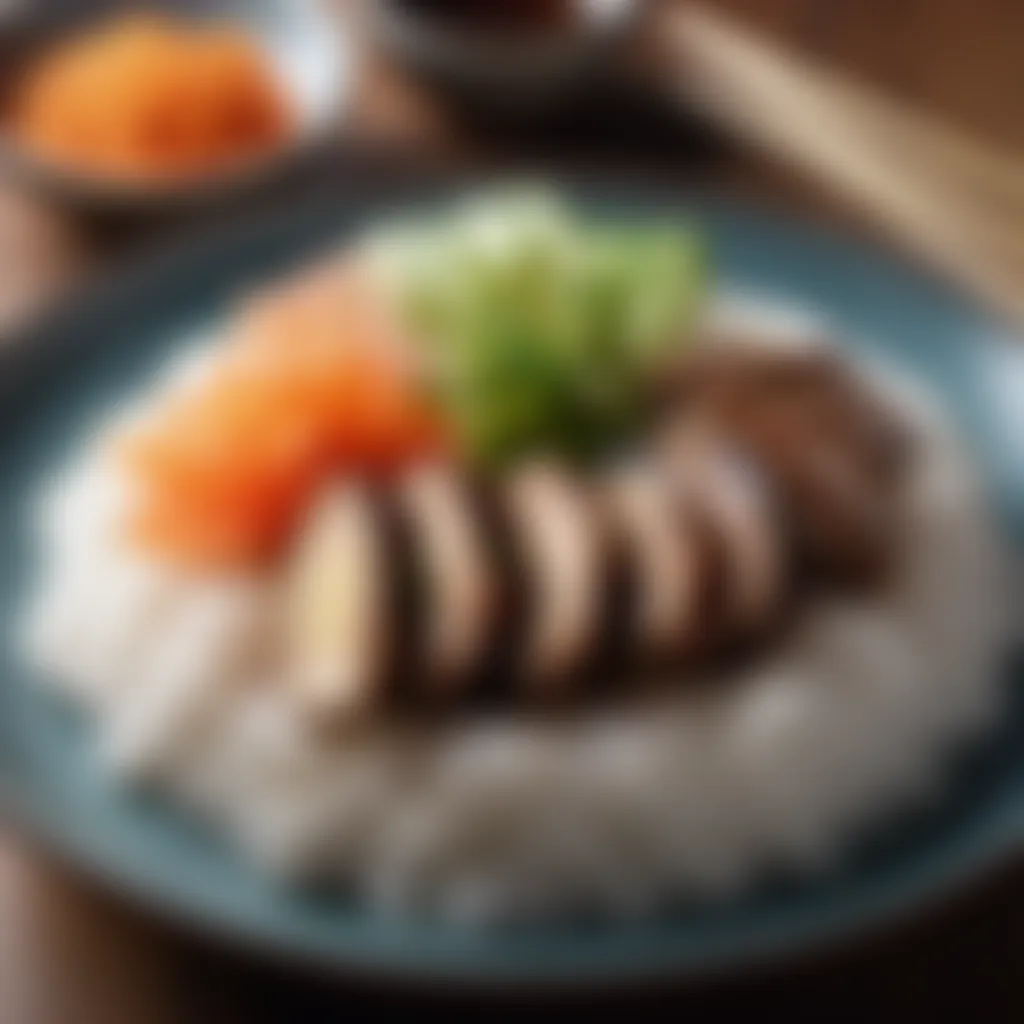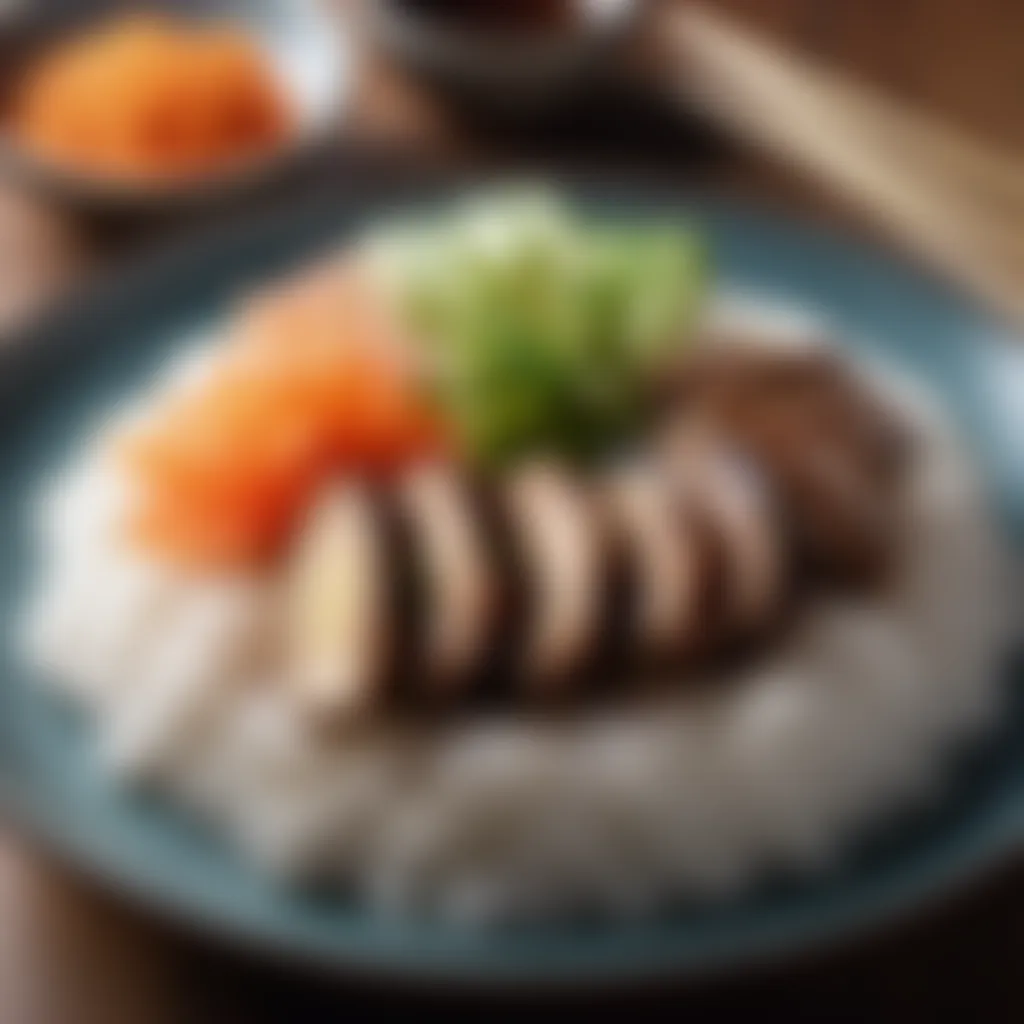Mastering Dwaejigogi: A Traditional Korean Delight


Intro
Cooking has always been an art form, an expression of culture and personal tastes. In this case, we're talking about Dwaejigogi, a delicious pork dish from Korea. It’s more than just food; it's a cultural experience that brings together family and friends.
Dwaejigogi isn’t just about taste; it's about the story behind each ingredient and every step in the process. From the tender juiciness of the pork to the aromatic spices that make it sing, preparing this dish requires not just a recipe but also an appreciation for the rich history that accompanies it. Let’s embark on this journey together!
Ingredients:
To create an authentic Dwaejigogi dish, you will need the following ingredients:
- Pork belly: 1 kg (2.2 lbs)
- Soy sauce: 1/2 cup
- Gochugaru (Korean red pepper flakes): 3 tablespoons
- Sugar: 3 tablespoons
- Garlic: 6 cloves, minced
- Ginger: 1 tablespoon, minced
- Sesame oil: 2 tablespoons
- Green onions: 2, chopped
- Black pepper: 1 teaspoon
- Rice wine: 1/4 cup
- Sesame seeds: for garnish
Preparation Steps:
Step 1: Selecting the Pork
Choosing the right cut is crucial. Pork belly is the go-to option for its richness and flavor. Look for a piece with a good balance of fat and meat.
Step 2: Marinating the Pork
- In a bowl, combine soy sauce, gochugaru, sugar, minced garlic, minced ginger, sesame oil, and rice wine.
- Stir well to form a marinade.
- Cut the pork belly into bite-sized pieces and add them to the marinade.
- Coat the pork evenly and let it sit for at least 30 minutes or refrigerate for up to 12 hours for deeper flavor.
Technical Aspects:
Temperature Settings
When it comes to grilling or pan-frying the pork, a medium-high heat is optimal. This allows the fat to render properly without burning the marinade.
Timing Specifics
Cooking time can vary depending on the thickness of the pork pieces, but generally, around 10-15 minutes on medium-high heat should suffice.
Cooking Process:
Step 1: Heating
- Preheat your pan or grill to medium-high.
- Add a small amount of oil to the pan if using a skillet.
Step 2: Cooking the Pork
- Place the marinated pork in the heated pan or grill.
- Sear the pork pieces for about 5-7 minutes on each side, or until they develop a golden-brown crust.
- Keep an eye to avoid charring. A lower heat might be necessary towards the end to ensure even cooking.
Step 3: Finishing Touches
Once cooked, toss in chopped green onions for an added crunch. Serve hot and sprinkle sesame seeds over the top.
Troubleshooting Tips:
- Dry Pork: If the pork is dry, it might be cooked too long or at too high heat. Keep an eye on the timings.
- Too Spicy: Adjust the gochugaru to your spice preference. You can lessen it if you want milder flavors.
- Sticking to the Pan: Ensure the pan is properly preheated. A little oil can help to prevent sticking.
By following these detailed steps, you'll not only end up with a plate full of Dwaejigogi but also with a greater appreciation for this beloved Korean dish. Let’s enjoy the fruits of our labor!
Prolusion to Dwaejigogi
Dwaejigogi isn't just another dish; it’s a tapestry of flavors, culture, and tradition woven into the fabric of Korean culinary artistry. Understanding this dish goes beyond merely knowing the ingredients; it's about appreciating the stories simmering within each bite and the social bonds it forges among those gathering around the table. A dish like Dwaejigogi invites everyone to come together, nurturing not only the body but also the spirit of community and belonging.
Understanding Korean Cuisine
Korean cuisine, known for its bold flavors and intricate preparation, represents a blend of various elements that elevate it to much more than merely food. One of its fundamental tenets is the harmony between flavors, where sweet, savory, and spicy notes meet to create a symphony for the palate. Dwaejigogi plays a crucial role here, as it showcases the art of balancing salty marinades with the natural sweetness of pork.
Moreover, ingredients such as soy sauce and garlic don’t just season the meat; they relate a narrative that resonates with the essence of Korean cooking—using simple ingredients to achieve profound flavor. The way Korean cuisine revolves around seasonal foods and regional specialties ensures that every meal mirrors the history and evolution of the culture itself.
Importance of Dwaejigogi


Dwaejigogi occupies a unique pedestal in the world of Korean food. It's not merely a dish; it acts as a catalyst for social interaction and familial bonding. Whether it’s a weekend barbecue or a chilly night in front of the fireplace, the sizzling sound of pork on the grill is often the signal for laughter and the sharing of stories. It’s a dinner that embraces warmth, not just in the flavors but in the connections it fosters.
But looking beyond the immediate pleasure it offers, Dwaejigogi also serves as a reflection of Korean history. Pork has had its ups and downs in popularity, influenced by various factors from economic changes to cultural shifts. Today, however, its prominence is indisputable. Cooking Dwaejigogi is, in essence, an act of treasuring history, honoring tradition, and enjoying the present all in one bite.
"Cooking brings people together; it tells a story of love, commitment, and culture—every meal is an opportunity to share a piece of one thing we all cherish: food."
As we continue this journey into the world of Dwaejigogi, we’ll explore its rich significance in family gatherings and how it contributes to the ever-evolving narrative of Korean dining culture.
Historical Context of Dwaejigogi
Understanding the historical context of Dwaejigogi is crucial in appreciating not just the dish itself, but also its significance within Korean culture. It’s not merely a recipe but a narrative, woven with threads of tradition, celebration, and social interaction. This section highlights two pivotal aspects that shaped the dish—its origins and its role in traditional celebrations.
Origins of Pork in Korean Cooking
The journey of pork in Korean culinary practices is a fascinating one. Pork has been a staple in Korean households for centuries. Historical records suggest that pig farming dates back to the farming settlements of the Neolithic period in Korea. The domestication of pigs provided a steady supply of meat, which began to integrate into the everyday diets of Koreans.
Throughout Korean history, pork has not just been a source of sustenance but also a medium of cultural expression. In ancient times, common people as well as royalty found ways to include this versatile meat in their dishes. Dwaejigogi, specifically, showcases the ingenious blend of marination and cooking techniques that enhance the pork's natural flavors, a testament to the culinary advancements over the years.
Pork’s prominence is also linked to the expansion of Confucian ideals during the Joseon Dynasty, where pork was often part of family gatherings and feasts, marking its importance in social settings. This deep-rooted connection between pork and Korean identity lays the groundwork for the appreciation of Dwaejigogi today.
Dwaejigogi in Traditional Celebrations
Dwaejigogi is often more than a meal; it occupies a revered position in numerous traditional celebrations across Korea. Whether it’s a joyous wedding feast or a solemn ancestral rite, the presence of Dwaejigogi adds a layer of depth to the occasion. For instance, during Chuseok—a harvest festival—families traditionally prepare Dwaejigogi to honor the spirits of their ancestors and to celebrate the abundance of the season.
The act of sharing food like Dwaejigogi resonates deeply in Korean culture, embodying the values of community and togetherness. When families gather around the table, the dish not only serves to satisfy hunger but also to foster bonds and create lasting memories. Strong flavors and the richness of marinated pork turn each bite into a connection with heritage and familial love.
Moreover, Samgyeopsal—grilled pork belly, a form of Dwaejigogi—has become highly popular in both home kitchens and restaurants, further emphasizing its importance in contemporary Korean society. The way pork is enjoyed during gatherings—often cooked right at the table and shared among loved ones—expresses a culinary philosophy rooted in interaction and respect for food.
"Food is not just about nourishment; it’s about the stories we share and the memories we create together."
Thus, the historical context surrounding Dwaejigogi enriches our understanding of this dish not just as a recipe but as a representation of collective experiences and cultural continuity. This narrative draws the lines connecting past and present, allowing for appreciation of a cuisine that is ever-evolving yet deeply anchored in tradition.
Essential Ingredients
In the creation of Dwaejigogi, understanding the essential ingredients is the backbone of this exquisite dish. The choice of components not only influences the flavor but also reflects the culture and tradition tied to Korean cooking. Properly selecting ingredients ensures that every bite encapsulates authenticity, making it a memorable experience for those whom you serve.
Selecting Quality Pork
When it comes to Dwaejigogi, choosing the right cut of pork lays the foundation for a savory outcome. Pork belly is often favored due to its rich fat content, bringing a luscious texture that enhances the dish. However, other cuts like shoulder or tenderloin can also work wonders, depending on how you plan to cook it. The key lies in sourcing fresh, high-quality pork.
Look for meat with a pinkish hue, fine marbling, and no strange odors. Visiting a local butcher might be the best bet to ensure you’re getting a freshly cut piece. Keep in mind that the butcher can often advise on the best cuts for marinating and grilling, so don’t hesitate to ask.
Marinades: The Flavor Foundations
Soy Sauce
Soy sauce acts as the heart of the marinade, providing the essential umami flavor that defines Dwaejigogi. One key characteristic of soy sauce is its savory and salty profile, which seamlessly penetrates the meat, providing both moisture and flavor. Using a good quality, naturally brewed soy sauce not only ensures depth in flavor but also adds an authentic touch to your dish.
While it's widely popular for marinades, be wary of using too much; its saltiness can overpower the dish if not balanced well with other ingredients.
Garlic and Ginger
Garlic and ginger are staples in Korean cuisine, each bringing its own charm to the table. Garlic, known for its punchy flavor, brings a warm spiciness that heightens taste sensations. Meanwhile, ginger adds a refreshing zest that cuts through the richness of the pork. Both ingredients are beneficial because they tackle not just flavor but also aid in digestion, making the dish lighter on the stomach.
Be sure to use fresh garlic and ginger for the best results. If you're in a pinch, powdered versions don't quite carry the same essence.
Sesame Oil
Sesame oil is prized for its nutty aroma and rich taste. When combined in the marinade, it creates a fragrant base that complements the pork beautifully. One unique feature of sesame oil is its ability to add a depth that other oils might miss. This oil thrives when used in small amounts, as it can easily become overwhelming. A little splash goes a long way, making it a delightful addition rather than a dominant force in the flavor profile.
Accompaniments and Side Dishes
Kimchi Variants


Kimchi is more than just a side dish; it's a staple at many Korean meals, including those featuring Dwaejigogi. Its fermented nature brings a tangy flavor that balances the richness of the pork. There are various variants, from spicy napa cabbage to cucumber kimchi; each adds its unique touch and helps cleanse the palate between mouthfuls.
What sets kimchi apart is its health benefits as well, packed with probiotics that support gut health. The challenge, however, lies in making or sourcing authentic kimchi that matches the dish.
Rice Options
Rice serves as a classic base for many Korean dishes, and Dwaejigogi is no exception. With multiple rice options available, sticky rice is often favored for its texture, perfect for scooping up delicious pork slices. However, other variations such as brown rice or even garlic fried rice can elevate the meal to new heights, providing diverse flavors and textures that enhance the dining experience.
Rice not only helps to make the meal more filling but also functions to soak up the juices from the meat, ensuring no flavor goes unappreciated.
Grilled Vegetables
Adding grilled vegetables takes the dish to another level. Toss in various seasonal veggies, like bell peppers, zucchini, or even mushrooms. They provide a contrast in texture and brightness to the pork. Beyond that, grilling brings out natural sweetness that pairs harmoniously with the meat.
The unique feature of grilled veggies is their versatility; they can be seasoned lightly or marinated to align with the flavors of the pork. However, remember to keep them simple so as not to overshadow the star of the show.
By focusing on each of these essential ingredients, you can truly capture the essence of Korean cooking through Dwaejigogi, showcasing both rich flavors and cultural traditions.
Preparation Techniques
When it comes to making Dwaejigogi, the techniques of preparation are crucial. These methods not only contribute to the texture and flavor of the dish but also enhance the dining experience. Knowing how to properly marinate and cook the pork can elevate this simple meal into something truly memorable. Here, we will discuss the art of marinating the pork and the various cooking methods that can be utilized to achieve superior taste.
Marinating the Pork
Marinating is essential for infusing flavor and tenderizing the meat. Through the proper timing and temperature, you can achieve a perfect balance of taste and texture.
Timing and Temperature
Timing and temperature play a significant role in marination. It's important to allow enough time for the meat to soak in the marinade. Typically, marinating Dwaejigogi for at least one hour is advised, but overnight in the refrigerator can work wonders. This duration helps the flavors seep into the meat, providing a depth that only slow absorption can deliver.
- The key characteristic of this timing is patience. Waiting for the right moment amplifies the flavor.
- Additionally, keeping the pork at a consistent cool temperature while marinating is particularly beneficial as it prevents bacterial growth. This makes it a healthy approach for all home cooks.
- However, a common pitfall occurs if one marinates too long, leading to a mushy texture. Finding that sweet spot is the goal in masterful marinating.
Refrigeration Best Practices
Lastly, best practices for refrigeration during marination cannot be overlooked. Keeping the pork properly refrigerated ensures that it remains safe to eat. Store the marinating meat in an airtight container to prevent cross-contamination.
- The temperature should be kept below 40°F (4°C), which is standard for meat storage.
- Using glass or stainless steel containers is a preferred choice because they won't react with the acids in the marinade.
- One unique aspect here is that marinating in glass allows the cook to see the marinade working its magic, which can be quite satisfying.
- A downside to refrigeration is that if forgotten, the marinated meat can lose flavor and freshness, so it’s best to keep a close eye on the time.
Cooking Methods
Once marinating is complete, the next step is cooking. The method you choose can transform your Dwaejigogi from good to great.
Grilling
Grilling is a popular choice for its ability to impart a smoky flavor that pairs exceptionally well with pork. This method allows for direct heat application, creating a caramelization on the outside while keeping the inside juicy.
- The charred exterior of grilled Dwaejigogi adds a visual appeal that is hard to resist.
- While grilling is enjoyable and often social, it requires close monitoring to prevent burning. This can be a minor drawback for beginners as it demands some skill and attention.
Pan-Frying
Pan-frying is another method that offers a crispy texture without needing a grill. This technique uses a small amount of oil, making it both convenient and the flavors very concentrated.
- The key characteristic here is simplicity; it’s often quicker than grilling.
- However, one must be cautious about temperature. If the pan is too hot, the meat can overcook outside while still raw inside. Balancing the heat is essential in achieving an even cook.
Braising
Finally, braising provides a gentle cooking approach, using moisture to cook the meat slowly to tenderness.
- This method often involves simmering the meat in a flavorful broth, allowing it to soak up flavors deeply. The slow cooking transforms tougher cuts into melt-in-your-mouth experiences.
- The unique feature of braising is its flexibility; you can include various aromatics and vegetables to infuse additional taste. Yet, it does require time. A quicker meal might not come from a braised approach, which can be a drawback for those seeking fast results.
Whether by grilling, pan-frying, or braising, the key lies in mastering the preparation techniques that make Dwaejigogi so signature in Korean cuisine. By being mindful of marination time and cooking methods, you are well on your way to crafting an unforgettable dish.
Serving Dwaejigogi


Serving Dwaejigogi is an essential part of the culinary experience, as it transcends mere consumption; it is an act of celebration and connection. This Korean dish, rich in tradition and flavor, merits careful consideration in both presentation and pairings. It’s not just about how the dish looks on the plate, but also how the accompanying elements can enhance its unique taste.
Presentation Techniques
A beautifully presented dish can elevate the dining experience and reflect the care that went into its preparation. For Dwaejigogi, the presentation can range from the simple to the elaborate. Here's how to do it right:
- Color Contrast: Using a variety of ingredients can create a vibrant palette on the plate. For instance, the shiny brown of the grilled pork juxtaposed with the bright greens of sautéed vegetables such as bok choy gives an eye-catching appeal.
- Layering: Arrange the Dwaejigogi slices slightly overlapping on a wooden or ceramic platter, emphasizing the juicy texture. You can place a handful of sesame seeds or sliced green onions on top for an added pop of color and flavor.
- Serving Style: Consider serving it family-style in the center of the table, allowing everyone to partake at their own pace. This approach fosters a communal atmosphere that aligns well with the dish’s origin in family gatherings.
Another technique is to use traditional Korean serving dishes, which can enhance the overall aesthetic of the dining experience. Small bowls for accompaniments like kimchi and rice not only serve a functional purpose but also add to the charm and authenticity of the meal.
Optimal Pairings and Beverages
Selecting the right accompaniments and beverages can significantly enhance the experience of enjoying Dwaejigogi. Here are some classic pairings that complement the richness of the dish:
- Kimchi: Whether it’s traditional napa cabbage kimchi or radish kimchi, the fermentation adds a tangy crunch that cuts through the richness of the pork.
- Rice Options: Steamed white rice is a staple that can absorb the juices of the pork. For a twist, try serving it with brown rice or even a fragrant jasmine rice to introduce new flavors.
- Grilled Vegetables: Charred zucchini or bell peppers served alongside Dwaejigogi complete the plate and provide an additional layer of smoky flavor.
When it comes to beverages, Koreans traditionally enjoy soju which is a distilled spirit that complements spicy and savory dishes well. Alternatively, a cold lager-style beer can also be refreshing. For those who prefer non-alcoholic options, a sweet ginger tea can provide a warm and comforting balance to the meal.
"Food is not just about sustenance; it's about connection and shared experiences. Every meal tells a story."
Cultural Significance
Exploring the cultural significance of Dwaejigogi reveals a rich tapestry interwoven with tradition, kinship, and shared culinary practices in Korea. This dish is more than just a meal; it symbolizes the essence of togetherness and the bonds that tie families and friends. When preparing Dwaejigogi, one engages in an age-old ritual that stretches back through generations. The process of selecting and marinating the pork often becomes an opportunity for family members to work side by side, sharing stories and laughter, reinforcing the relationships that matter most.
Moreover, the significance of Dwaejigogi in family gatherings cannot be overstated. It holds a revered place on tables during special occasions, such as birthdays and important celebrations, creating a sense of warmth and community among guests. The sizzling sound of marinated pork on the grill is not merely an auditory pleasure; it signals that a joyful feast is about to commence. Family recipes, passed down through the ages, become a source of heritage that connects the past with the present, ensuring that the flavors and stories endure.
"Food is not just sustenance; it’s a bridge connecting generations, cultures, and hearts."
Additionally, the presence of Dwaejigogi at festive occasions underscores its role in Korean social rituals. This dish is commonly prepared during celebrations like Chuseok, which is akin to a harvest festival, where families reunite to honor their ancestors and share blessings. In such contexts, Dwaejigogi signifies prosperity and gratitude, evoking a sense of continuity that resonates deeply within the Korean ethos.
Dwaejigogi in Family Gatherings
In Korean culture, Dwaejigogi often takes center stage at family gatherings, serving as a catalyst for conversation and connection. A typical family meal involving this dish is vibrant, filled with an array of shared side dishes called banchan like kimchi and pickled vegetables, making the dining experience communal. When Dwaejigogi is grilled at the table, it encourages an interactive experience where family members engage in cooking and serving, reinforcing bonds through shared effort and enjoyment.
The act of gathering around the grill fosters an inviting atmosphere, making it easy for everyone to partake in the meal. The aroma wafting through the air provides comfort and familiarity, elements that enhance the dining experience. When families come together to enjoy Dwaejigogi, it often leads to deep conversations and moments of laughter, transforming a meal into precious memories.
Furthermore, during major holidays like Seollal (Lunar New Year), families prepare Dwaejigogi as part of their feast to symbolize new beginnings and shared fortune. Ingredients may be sourced from local markets, emphasizing community ties, while recipes might be tweaked with personal twists, allowing individuality within tradition.
Regional Variations of Dwaejigogi
The beauty of Dwaejigogi lies not only in its core recipe but also in its regional variations that reflect local elements and preferences across Korea. Each region boasts its distinctive style, demonstrating the adaptability of this dish while maintaining its fundamental essence.
For instance, in Jeolla Province, it is common to encounter Dwaejigogi marinated with a heady mix of local spices, giving it a robust flavor profile that resonates with the culinary identity of the area. In contrast, the Busan region may feature a more seafood-inflected version, incorporating ingredients like sesame oil and fresh herbs that mirror coastal influences.
Some families in the eastern parts of Korea prefer a slightly sweeter marinade, blending fruits like pear or apple to tenderize the meat and infuse it with a touch of natural sweetness. Meanwhile, in the urban settings of Seoul, the dish often adopts modern interpretations, where chefs experiment with fusion takes and innovative ingredients.
This regional diversity not only showcases the culinary creativity of the Korean people but also highlights the importance of locality in the preparation of Dwaejigogi. Each variation serves as a culinary fingerprint, showcasing local traditions, ingredients, and individual family gatherings, ultimately enriching the shared meal that is Dwaejigogi.
Culmination
The conclusion of this article serves as a vital point, wrapping up our journey through the art of making Dwaejigogi. It’s not just the end but a culmination of flavors, techniques, and cultural narratives that have come together to present a dish that is more than food; it embodies tradition and the warmth of family gatherings.
Reflections on the Cooking Process
When you step back and consider the cooking process for Dwaejigogi, it’s clear how much care and attention go into each step. From selecting pork that promises tenderness to marrying it with marinades that elevate taste, every action forms a part of a larger story. The patience required in marinating is truly an act of love, coaxing out flavors that would otherwise remain hidden.
Cooking isn't just about fuel; it’s a way of expressing yourself. Each batch of Dwaejigogi is imbued with the cook's personality, adapting traditional methods to modern conveniences or family preferences. The sizzle of meat on a hot grill and the aroma wafting through the kitchen lead to an experience of communal joy, making it a centerpiece during family gatherings or celebrations. As you cook, be sure to reflect on the memories each dish can create. Connecting with your roots while exploring personal tastes can make all the difference.
Encouragement for Culinary Exploration
The world of cooking is vast and unfathomably rich, and Dwaejigogi is just one of many avenues to explore. As you cultivate your newfound skills in making this delectable dish, consider branching out. Don’t hesitate to experiment with different marinades or side dishes. Adding a pinch of this or a splash of that can lead to delightful surprises. Every kitchen can become a laboratory for culinary exploration, where the only limits are the pages of cookbooks and your imagination.
Seek out inspiration from various cultures; perhaps a fusion of Dwaejigogi with Japanese teriyaki, or even incorporating elements from other Korean recipes like Bibimbap.
Remember, every dish you try, every ingredient you use, is a chance to grow your culinary palette. Get your hands a little messy, and let the kitchen become your sanctuary – a place where laughter, creativity, and memories are made. Don't shy away from making mistakes; they often lead to the best learning experiences.
Ultimately, the art of cooking is about connection, whether it’s through food shared with loved ones or through the exploration of diverse cultures and cuisines.
"Cooking is about creating memories for yourself and for others. So, let every meal be a celebration."
With the richness of flavors and experiences you're sure to create, Dwaejigogi can become more than just a meal; it can transform into a cultural experience worthy of sharing around your dining table.







